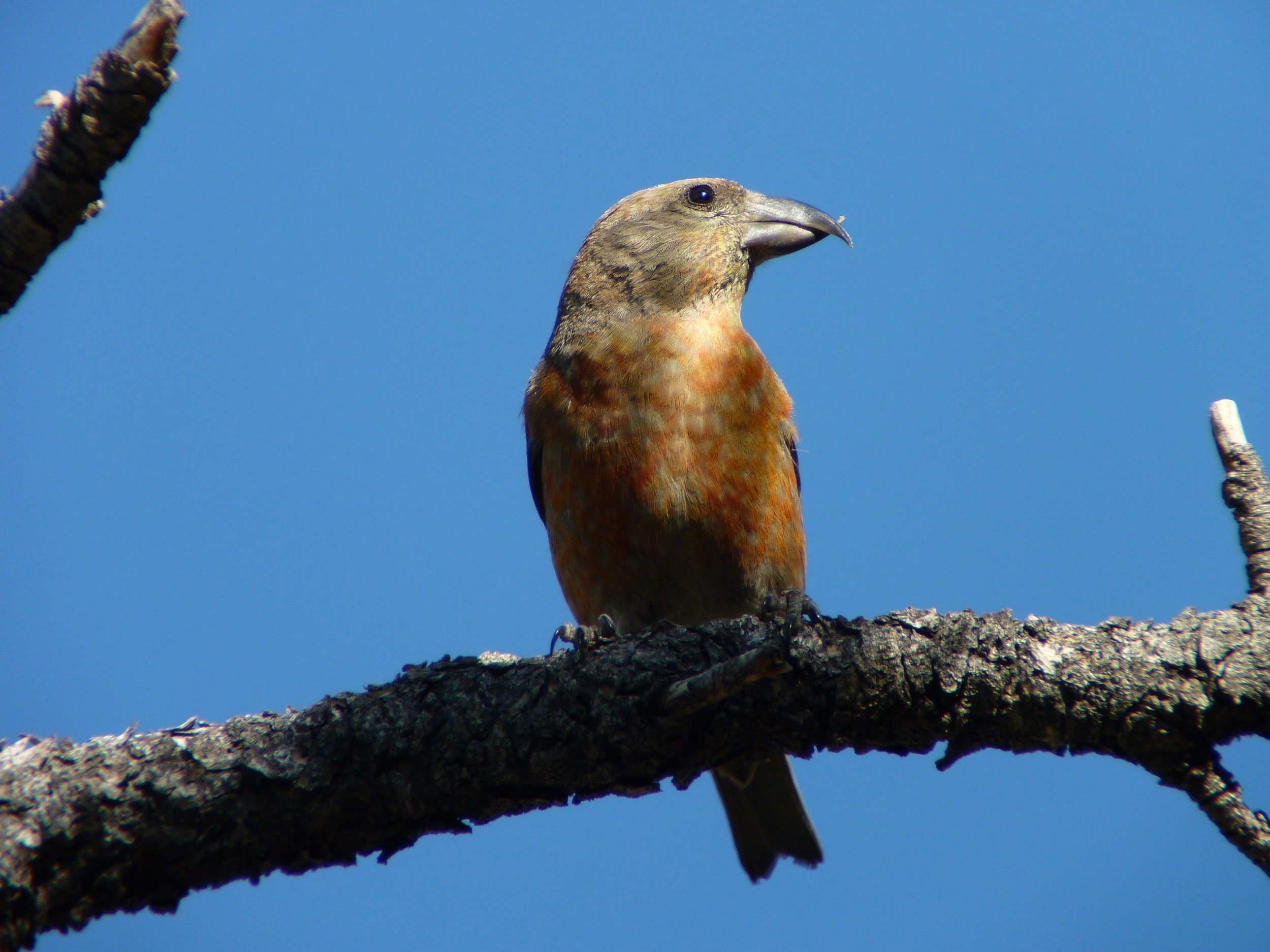January Nature Almanac: Red Crossbills Usher in the New Year
By Scott Severs and Ruth Carol Cushman
January 2022
We’re not sure why the holiday season makes us think of Red Crossbills. Memories of the colorful red birds adorning the green spires of fir and spruce during a snow squall may have something to do with it. Looking a bit like Christmas tree ornaments, male Red Crossbills vary from dull orange to brick red. Females are adorned with olive-yellow tones. Hardy creatures, crossbills are able to withstand the harshest winter weather nature can bring on, as long as food remains available. A finch relative, they are found throughout the foothills and mountains of Colorado.
A young male Red Crossbill showing the characteristic crossed tips of the bill that is used to pry open pinecones to get to the seeds. Photo by Scott Severs.
Occasionally, local birders are treated to sightings of the smaller White-winged Crossbill, especially in high elevation spruce/fir forests.
Like many others, this species has evolved by adapting to a specific food source. Crossbills use a pair of overlapping mandibles like a wedge to force apart the cone scales of pine, spruce, and fir. Their flexible tongues then remove the tiny, winged seeds. Among individuals, birds can even have left and right-crossed bills. This remains a mystery for the advantage, but researchers speculate that this may help reduce food competition between individuals.
Sociable birds, large flocks of crossbills work over the crowns of evergreens for seeds, announcing their presence with jeep-jeep calls. Nesting may occur anytime between January and August- yes, crossbills have nested in mid-winter when the cone crop remains bountiful. Breeding males sing a bright twittering song, often in a courtship flight encircling the female as she sits in the crown of a pine tree. She will lay three to five light blue or green eggs flecked with brown spots, in a nest built of twigs, rootlets, and strips of bark placed in the needles of a pine. The young hatch in two weeks and leave the nest about two weeks later.
Crossbills have an internal adaptation for winter survival. About halfway down their esophagus, there’s a pouch for storing seeds to help provide energy during cold nights or in extreme weather.
Cone crops are seasonal and occasionally fail. In those years, crossbills may undergo a huge migration southward, known as an irruption. During this mass exodus, crossbill flocks and other finches may turn up in strange places searching for food. This winter appears to be such a year, with limited numbers of crossbills being sighted in the region.
All too often, crossbills are victims of auto collisions. Because they are fond of salt, they feed on road salt spread by highway crews to melt snow and ice. Many are killed by traffic along mountain passes.
Places to search for crossbills in Boulder County include Walker Ranch and the mountain parks. Crossbills seem to start appearing near feeders as the holidays approach. You do not need pine seeds to attract Red Crossbills as they thrive on oil sunflower seeds as well.
Let’s hope they keep their beaks crossed for a Happier New Year for all furred and feathered creatures.
Other January Events
Watch for songbird winter visitors from Canada and Alaska including Northern Shrike, American Tree Sparrow, and Common Redpoll.
Mark calendars for the conjunction of a crescent Moon with Mars and Venus on January 28 in the southeast sky just before dawn.
Great Horned Owls and Bald Eagles begin nesting. Please be respectful of their personal space.
Try identifying winter tracks in the snow. Look for mice, voles, weasels, mink, and coyotes among others.
The Boulder Christmas Bird Count tallied about 105 species, but low population numbers for many typically common winter birds.
Learn more about crossbills by watching Dr. Craig Benkman’s presentation Some Crossbill Natural History and the Cassia Crossbill from the November 2021 Boulder County Audubon meeting.

